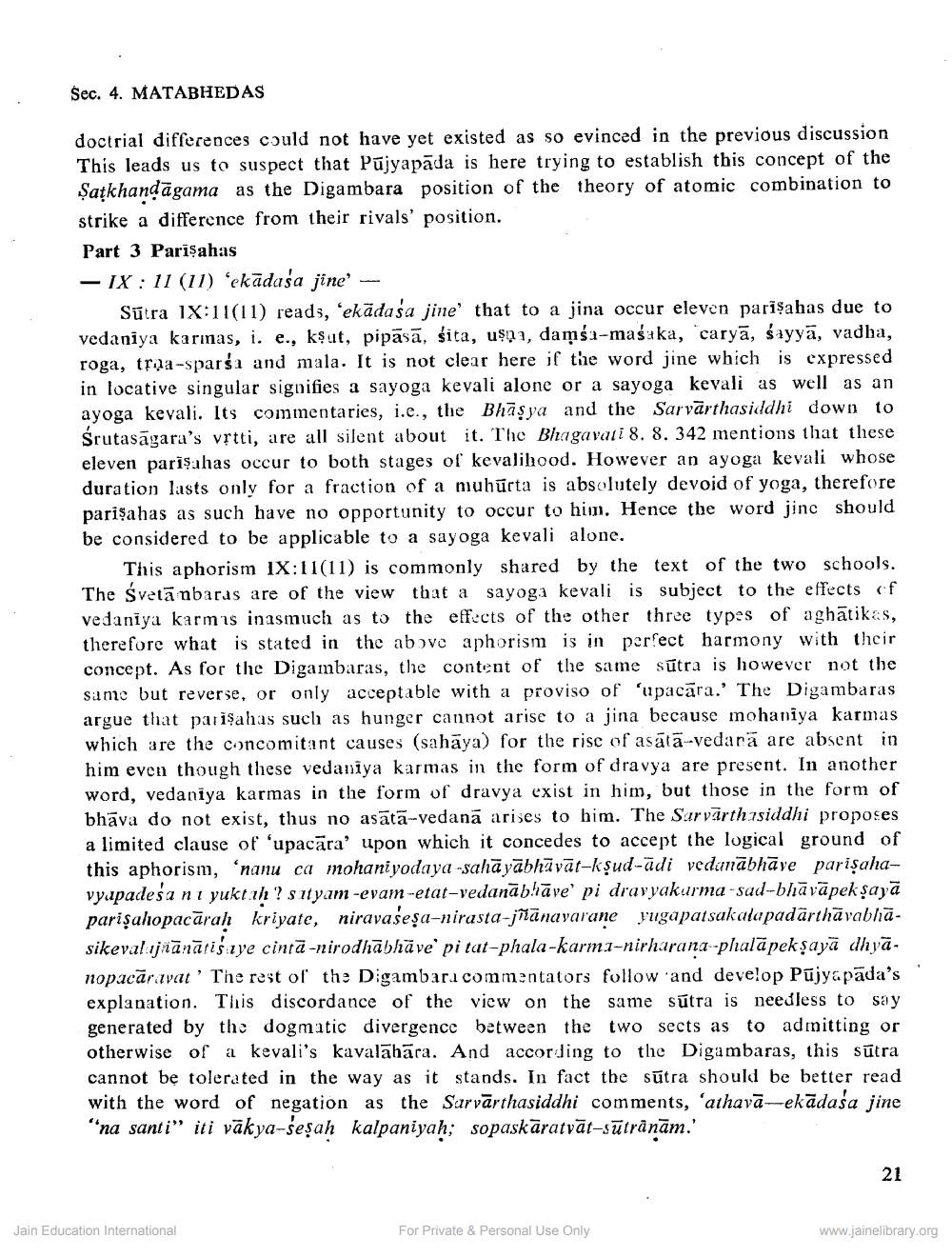________________
Sec. 4. MATABHEDAS
doctrial differences could not have yet existed as so evinced in the previous discussion This leads us to suspect that Pūjyapāda is here trying to establish this concept of the Şațkhandāgama as the Digambara position of the theory of atomic combination to strike a difference from their rivals' position. Part 3 Parişahas - IX: 11 (11) 'ekādaśa jine -
Sūtra 18:11(11) reads, 'ekādaśa jine' that to a jina occur eleven parişahas due to vedaniya karinas, i. e., kşut, pipāsā, śita, uşņi, damsa-masaka, caryā, sayyā, vadha, roga, troa-sparsa and mala. It is not clear here if the word jine which is expressed in locative singular signifies a sayoga kevali alone or a sayoga kevali as well as an ayoga kevali. Its commentaries, i.e., the Bhāsya and the Sarvārthasiddhi down to Śrutasagara's vịtti, are all silent about it. The Bhagavati 8. 8. 342 mentions that these eleven parişahas occur to both stages of kevalihood. However an ayoga kevali whose duration lasts only for a fraction of a muhurta is absolutely devoid of yoga, therefore parişahas as such have no opportunity to occur to him. Hence the word jinc should be considered to be applicable to a sayoga kevali alone.
This aphorism 1X:11(11) is commonly shared by the text of the two schools. The Svetā nbaras are of the view that a sayoga kevali is subject to the effects of vedaniya karmis inasmuch as to the effects of the other three types of aghātikas, therefore what is stated in the above aphorism is in perfect harmony with their concept. As for the Digambaras, the content of the same sūtra is however not the same but reverse, or only acceptable with a proviso of 'upacara.' The Digambaras argue that parişahas such as hunger cannot arise to a jina because mohaniya karmas which are the concomitant causes (sahāya) for the rise of asalā-vedarā are absent in him even though these vedaniya karmas in the form of dra vya are present. In another word, vedaniya karmas in the form of dravya exist in him, but those in the form of bhāva do not exist, thus no asātā-vedanā arises to him. The Sarvärthasiddhi proposes a limited clause of 'upacara' upon which it concedes to accept the logical ground of this aphorism, 'nanu ca mohani yodaya -sahāyābhāvāt-kşud-ādi vedanābhāve parişahavyapadesa ni yuktah? sit yam-evam-etat-vedanābhāve' pi dravyakurma-sad--bhāvāpek şayā parişahopacārah kriyate, niravašeșa-nirasta-jñänavarane yugapatsakalapadārthāvabhāsikevaljnānālisiye cintā-nirodhābhāve pi tat-phala-karma-nirharana--phalāpekṣayā dhyā. nopacāravat’ The rest of the Digambar commentators follow and develop Pūjyapāda's explanation. This discordance of the view on the same sūtra is needless to say generated by the dogmatic divergence between the two sects as to admitting or otherwise of a kevali's kavalāhāra. And according to the Digambaras, this sūtra cannot be tolerated in the way as it stands. In fact the sūtra should be better read with the word of negation as the Sarvārthasiddhi comments, 'athavā-ekādaśa jine "na santi" iti vākya-seşah kalpaniyah; sopaskāratvāt-sūtrânām.'
21
Jain Education International
For Private & Personal Use Only
www.jainelibrary.org




